A History of the County of Northampton: Volume 3. Originally published by Victoria County History, London, 1930.
This free content was digitised by double rekeying. All rights reserved.
'Parishes: Finedon', in A History of the County of Northampton: Volume 3, ed. William Page (London, 1930), British History Online https://prod.british-history.ac.uk/vch/northants/vol3/pp196-203 [accessed 31 January 2025].
'Parishes: Finedon', in A History of the County of Northampton: Volume 3. Edited by William Page (London, 1930), British History Online, accessed January 31, 2025, https://prod.british-history.ac.uk/vch/northants/vol3/pp196-203.
"Parishes: Finedon". A History of the County of Northampton: Volume 3. Ed. William Page (London, 1930), British History Online. Web. 31 January 2025. https://prod.british-history.ac.uk/vch/northants/vol3/pp196-203.
In this section
FINEDON
Tingdene, Thingdene (xi cent.); Thyngden, Tynden (xiii cent.); Thynden (xiv cent.); Thingdon (xvi cent.); Finedon (xviii cent.).
The parish of Finedon contains 3,541 acres of land. It rises to a little over 300 ft. above the ordnance datum from the River Ise which forms the western boundary. The sub-soil is Upper Lias, and Great and Inferior Oolite, the surface soil being clay producing wheat and barley. The parish was formed into an urban district in 1894 with a council of twelve members. It was inclosed under a private Act of Parliament. (fn. 1) The large village lies at the intersection of the roads from Wellingborough to Thrapston and from Higham Ferrers to Kettering. It is a somewhat uninteresting looking town of redbrick houses, a red brick water tower on the Irthlingborough road being a prominent landmark. The rectory house stands on the north-west of the church and is a well-designed building of two stories, faced with ironstone and roofed with Collyweston slates, erected in 1688 by Roger Altham, rector. A few late 17th or early 18th century houses remain in the old part of the town, one of them in Mulsho Square with a thatched roof, is dated 1693 and another in the same square is dated 1736. In Church Street, the Charity School for girls is a well-designed two-story house with slated roof erected in 1712, while the Gothic revival is represented by the Almshouses in the same street, built in 1847 and by the Bell Inn. At the west end of the town is the Old Hall or manor house which was rebuilt about 1835, (fn. 2) and enlarged some twenty years later, (fn. 3) but it incorporates on the north-west side some rooms belonging to a former structure, which appears to have been an Elizabethan house of only moderate size. The existing mansion is a picturesque gabled building of local yellow stone, with Weldon stone dressings. (fn. 4) Iron-stone was formerly worked and the Finedon Ironworks belonging to the Glendon Iron Ore Company are now disused. The principal industry at the present time is the manufacture of boots and shoes. Finedon station on the London Midland and Scottish Railway is two miles from the village in Isham parish.
Manors
In the reign of Edward the Confessor, Queen Edith held the great soke of Finedon, which contained 27 hides of land in six hundreds. In 1086 it was in the king's hands and formed part of the ancient demesne of the crown. Only 11 hides were in the later hundred of Huxloe and a holding of 9½ hides seems to represent the manor of FINEDON. (fn. 5) In the 12th century survey of the county, the king held 10 hides there. (fn. 6) The men of Finedon in 1388 successfully claimed that it was ancient demesne and proved their right to be quit of toll throughout the kingdom. (fn. 7) The sokemen of the ancient demesne appear in a rental of the manor in 1423. (fn. 8) The manor apparently remained in the crown until King John granted it in 1200 for life at fee-farm to his clerk, Stephen de Clay, (fn. 9) who was holding it in 1209. (fn. 10) In 1217 it was granted to Thomas Malemains (fn. 11) and in 1218 to William Longsword, Earl of Salisbury, (fn. 12) who possibly retained it till his death in 1226. (fn. 13) At some time, however, it was granted to the justiciar, Hubert de Burgh, but after his outlawry, (fn. 14) it was given to Stephen de Segrave and his heirs. (fn. 15) Stephen's son Gilbert was holding the manor in 1234, when he was ordered to restore it to Hubert de Burgh. (fn. 16) In 1241 it was at farm to the men of Finedon, (fn. 17) but in the same year the manor was granted in fee to William, son of William de Forz, count of Aumale, and his wife Christina, daughter and heir of the Earl of Chester, in part compensation for her inheritance in the earldom. (fn. 18) In 1246 they granted one moiety of the manor to Richard de Bolebec, (fn. 19) but retained the other moiety, which passed to their daughter Divorgilla, the wife of John Balliol. (fn. 20) From her it went to John de Burgh, grandson of the justiciar. (fn. 21) On his death in 1279, (fn. 22) his moiety was assigned to his eldest daughter, Divorgilla, the wife of Robert Fitz Walter, Lord Fitz Walter, who in 1283 sub-infeudated their moiety of Finedon. (fn. 23) One quarter of the manor was granted to Ralph de Kirketon, who held it by the service of a quarter of a knight's fee. (fn. 24) He demised it to William Bernak, probably only in settlement on Alice de Kirketon. (fn. 25) Alice may have been identical with Alice the wife of John de Thorp, who jointly with her husband was holding it in 1321. (fn. 26) She granted it for his life to John de Harwedon, who was the tenant in 1334, (fn. 27) but in 1341 William de Thorp sold the reversion to Simon Simeon of Grimsthorp. (fn. 28)
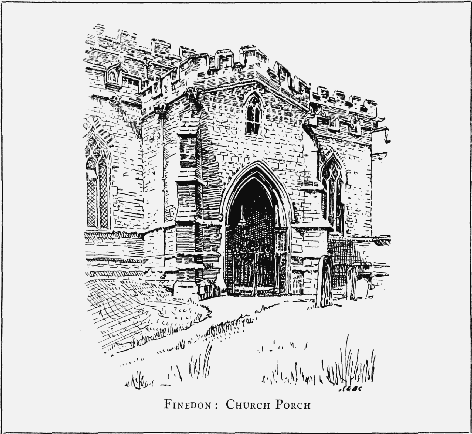
Finedon: Church Porch
The other quarter of the manor was granted by the Fitz Walters in 1283 to Ralph Seymour, also for the service due from a quarter of a knight's fee. (fn. 29) In 1310, however, the service had been changed to the yearly gift of a pair of gilt spurs. (fn. 30) Ralph died seised in 1310 (fn. 31) and after the death of his widow Alice, who held it for life, (fn. 32) it passed to his son Edmund. (fn. 33) Lawrence Seymour was holding it in 1334 (fn. 34) presumably as a trustee for settlements made on Thomas Seymour, (fn. 35) but the latter sold it in 1348 to Simon Simeon, (fn. 36) who thus became possessed of the whole moiety of the manor. He settled it jointly on himself and his wife Elizabeth Neville. (fn. 37) He died without heirs, (fn. 38) and Elizabeth brought the manor to her second husband John la Warre, (fn. 39) who died seised of it in 1398. (fn. 40) She had predeceased him, and his heir was his brother Thomas, (fn. 41) who seems to have sold the moiety of Finedon manor between 1400 and 1405 to John Mulsho; (fn. 42) at the same time Mulsho obtained a quarter of the other moiety of the manor (q.v.). He was succeeded by his son, who died in 1478, and his grandson, who died in 1536, both named John. (fn. 43) Thomas, the grandson of the third John Mulsho, succeeded him (fn. 44) and bought the remainder of the other moiety of Finedon manor (q.v.), which had been alienated by the Count of Aumale in 1246 (fn. 45) so that from this time the whole manor was held by the Mulshos. Thomas's eldest son, another Thomas, sold the manor in 1604 to his brother Robert (fn. 46) from whom it passed in direct descent to William, Robert (fn. 47) and Tanfield Mulsho. (fn. 48) On Tanfield's death his heirs were his daughters Anne and Elizabeth, who married two brothers Gilbert and John Dolben, the sons of the Archbishop of York, but Anne and Gilbert bought Elizabeth's share. (fn. 49) Gilbert was created a baronet in 1704 (fn. 50) and his successors were lords of the manor till the death of Sir John English Dolben in 1837, (fn. 51) when it passed to his daughter Frances, the wife of William Mackworth, who took the name of Dolben. (fn. 52) She died in 1892, and the last owner of the manor was her daughter Ellen Mackworth Dolben, on whose death in 1912, the whole estate was sold in separate portions. (fn. 53)
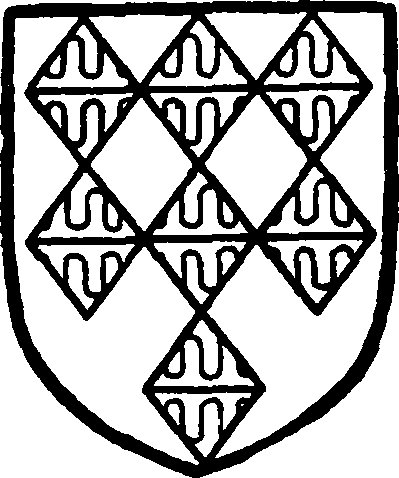
de Burgh. Gules seven lozenges vair.
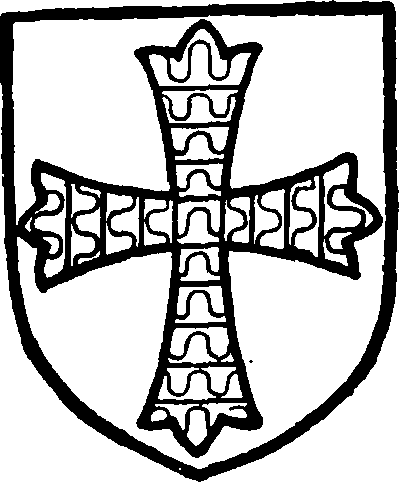
de Forz. Gules a cross paty vair.
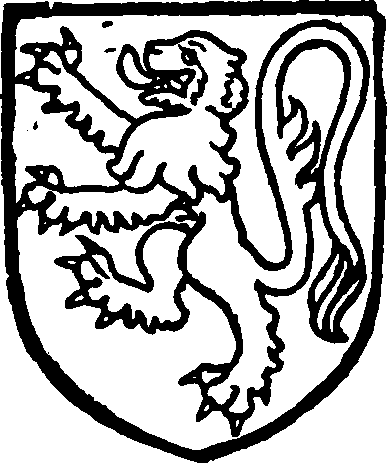
Bolbec. Vert a lion argent.

Fitzwalter. Or a fesse between two cheverons gules.
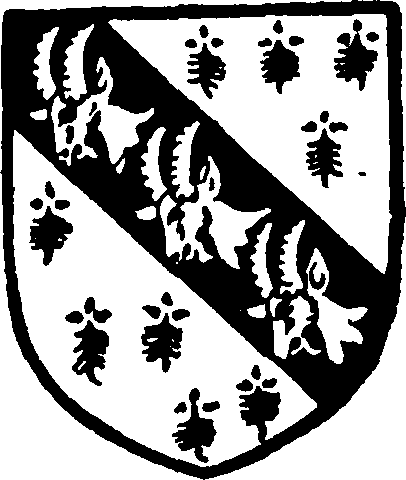
Mulsho. Ermine a bend sable with three goats' heads razed argent with horns or thereon.
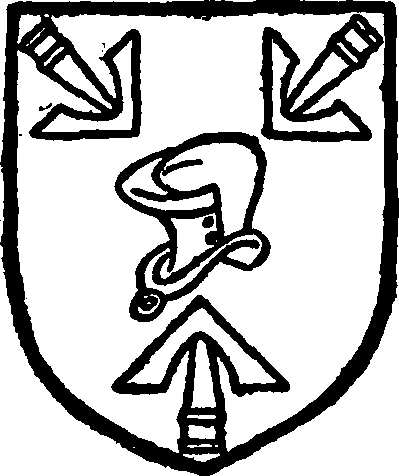
Dolben. Sable a helm between three broad arrow heads argent all pointing inwards.
The moiety of the manor of Finedon which Lord FitzWalter and his wife granted in 1246 to Richard de Bolbec was held by the annual payment of a pair of gilt spurs. (fn. 54) On the death of Richard's son Hugh in or before 1262, it was divided between Hugh's four daughters and heirs, Philippa, the wife of Roger de Lancaster, Margery, the wife of Nicholas Corbet, Alice the wife of Walter, son of William de Huntercombe, and Maud who was then unmarried. (fn. 55)
Philippa's eighth part of the manor passed on her death before 1294 to her son John de Lancaster, (fn. 56) who was holding it in 1321. (fn. 57) It was then held in demesne by John, son of Robert de Lancaster, (fn. 58) but probably before 1327 it had passed to Robert de Sandford. (fn. 59) In 1342, Robert gave it to his son Thomas and Margaret Spryng, (fn. 60) but in 1367 Thomas de Sandford sold it to Simon Symeon of Grimsthorp, (fn. 61) and from that date it seems to have followed the descent of the other moiety of the manor (q.v.) since John Mulsho died seised in 1478 of one moiety and a fourth part of the other moiety. (fn. 62)
The eighth part assigned to Margery and Nicholas Corbet was granted to Robert Burnel, Bishop of Bath and Wells, (fn. 63) presumably as trustee of a settlement on Margery, daughter of Nicholas and wife of Ralph fitz William of Greystock. (fn. 64) The latter enfeoffed his son Robert and his wife Elizabeth with all his lands in Finedon. (fn. 65) Robert died seised in 1315 (fn. 66) and his widow was the tenant in 1334. (fn. 67) Their direct descendants in the male line held this part of Finedon till the death of Ralph, Baron Greystock, in 1487. (fn. 68) It then passed to his granddaughter Elizabeth, who married Thomas, Lord Dacre of Gillesland. (fn. 69) The Dacres seem to have sold or demised it to James Harrington, who brought an action for recovery of the manor against Sir William Dacre. (fn. 70) Two years later Harrington conveyed it to Sir Robert Brudenell. (fn. 71) The latter left it to his son Anthony, (fn. 72) but it came into possession of Sir Robert's eldest son and heir Thomas, (fn. 73) who sold it in 1542 to Thomas Mulsho, (fn. 74) the lord of the other moiety of Finedon Manor (q.v.).
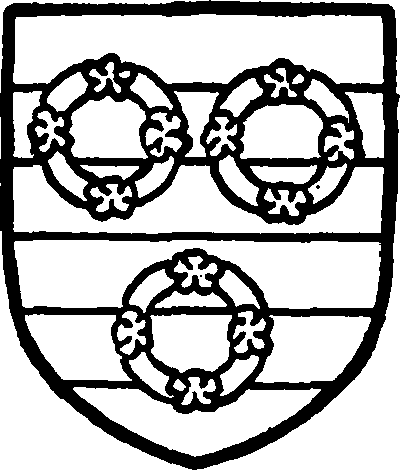
Greystock. Barry argent and azure three wreaths gules.
The share in the Bolebec moiety of Finedon, assigned to Alice, wife of Walter de Huntercombe, (fn. 75) was demised by them to Master Giles de Barinton, who, presumably for his own life, granted it to Robert Burnel, Bishop of Bath and Wells. (fn. 76) The latter died seised in 1292 and his heir was his nephew Philip. (fn. 77) Barinton was apparently holding it as trustee for Amice de Shepey, possibly the daughter of Alice de Huntercombe, (fn. 78) and when Philip Burnel died about 1294, except for a small holding, (fn. 79) it was in the hands of William de Shepey. In 1321, it had passed to John Poleyn and his wife Amice, (fn. 80) who had also come into seisin of the fourth and last share of the moiety of Finedon manor (q.v.).
The youngest daughter of Richard Bolebec, Maud, married Hugh de Laval, who after her death, gave her pourparty, during his life-time, to Robert Burnel, Bishop of Bath and Wells, who thus held a quarter of the manor of Finedon. (fn. 81) On the Bishop's death, it passed to his nephew Philip Burnel. (fn. 82) Hugh de Laval died about 1301 and his wife's share passed to her nephew John de Lancaster. (fn. 83) The latter, however, only held as a mesne lord, as this share passed with the other eighth share held by the Bishop to Amice de Shepey and William de Shepey. (fn. 84) In 1321, the quarter part of the manor had passed to John Poleyn and his wife Amice, (fn. 85) who is said to have been the daughter of Amice de Lacey, (fn. 86) but she was presumably descended from the Shepeys. In 1412, a lady Poleyn had a rent of 10 marks in Finedon, (fn. 87) but in 1415, the fourth part of the manor had passed to Rose, the wife of John Fish of Bishop's Hatfield. (fn. 88) Rose was a descendant of the daughter of John and Amice Poleyn. (fn. 89) In 1415, she and her husband sold it to William Sackville. (fn. 90) A hundred years later, it is said to have been in the hands of Thomas Sackville, who sold it about 1515 to Michael or possibly, more correctly, to Nicholas Boughton. (fn. 91) In 1521, Edward, the son of Nicholas Boughton, granted it to John Docwra and Thomas Sackville. (fn. 92) In 1569, Thomas Docwra and his wife sold the quarter part of the manor to Thomas Mulsho, (fn. 93) who thus became lord of all the pourparties of the manor of Finedon. It should be noted, however, that in a Chancery case of 1533–38, John Saby is said to have been lord of the manor of Finedon, (fn. 94) while about 1542, Gabriel Shaller and Robert Plante and his wife Margaret sold a quarter part of the manor to William Franklin, who had been succeeded before 1579 by his son Nicholas. (fn. 95) What right these tenants had in the manor does not appear.
A manor called THINGDEN and BURTON LATIMER may be traced in part to two holdings, one of half a hide in Finedon and the other of one and a half hides in Burton Latimer, which Burred held in the time of Edward the Confessor. (fn. 96) Burred also held two hides and three virgates of land in Burton, but whether these formed part of the later manor is not certain. (fn. 97)
The three holdings passed to the Bishop of Coutances, (fn. 98) and the first two seem certainly to have passed with much of his Northamptonshire land to the Clares, as the manor was subsequently held by knight's service of the Honour of Gloucester. (fn. 99) In 1086, the bishop's sub-tenant in the two small holdings was named Richard. (fn. 100) In the Northamptonshire survey, William de Houton held one and a half hides in Burton, (fn. 101) but the half hide in Finedon is not mentioned. In 1222, Robert, son of Richard, granted a messuage and 27 acres of land in Finedon and rents from 7 virgates of land in Burton and Finedon to the Abbot of Croxton in frankalmoin. (fn. 102) In 1250, this grant was confirmed by Richard, Earl of Gloucester. (fn. 103) After the dissolution of the Abbey, Henry VIII granted the manor of Thingden and Burton Latimer in 1539 to Thomas, Earl of Rutland, and his wife Elizabeth. (fn. 104) In 1555, his son Henry, Earl of Rutland, sold it to Richard Lambert, citizen and grocer of London, (fn. 105) who immediately re-sold it to Edward Jackman, a fellow grocer. (fn. 106) In 1561, it was sold by Jackman to John Isham (fn. 107) and in 1564 it passed to Richard Peacock. (fn. 108) Peacock died in 1616, and the manor passed under a settlement of 1604, to his cousin William Peacock, who was succeeded in 1625 by his son Richard. (fn. 109) The latter sold it in 1659 to William Downhall, (fn. 110) who with his wife sold it in 1671 (fn. 111) to Thomas Goodinge. It passed about 1673 to Tanfield Mulsho, (fn. 112) the lord of the main manor of Finedon (q.v.).
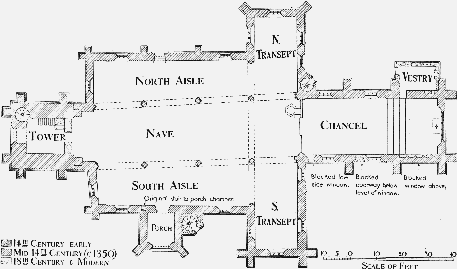
Plan of Finedon Church
A market was held at Finedon at the end of the 13th century (fn. 113) and in 1330, the holders of the various pourparties of the manor claimed to have a view of frank-pledge, a market every Thursday, thourtol, waif, infangthief, together with gallows, tumbril and pillory, for their tenants. The right of thourtol, however, was recovered at this time by the Crown. (fn. 114) In the early 18th century part of the gallows was still standing. (fn. 115) A grant of the right of free warren in his demesne lands was made to Simon Simeon in 1386 (fn. 116) and is mentioned in 1720. (fn. 117) A free fishery is mentioned in 1301 (fn. 118) and it seems, like the other privileges, to have been divided amongst the holders of the different parts of the manor. It is mentioned in the various transfers of the manor and appears in 1720. (fn. 119)
Three mills are mentioned in Domesday Book, but presumably they were not all at Finedon itself. (fn. 120) In the 14th century there was apparently only one watermill, divided up similarly as the manor, (fn. 121) but in 1650 and 1661 3 water-mills and a windmill are mentioned. (fn. 122)
Church
The church of ST. MARY-THEVIRGIN consists of chancel 51 ft. by 21 ft., north and south transeptal chapels 31 ft. by 16 ft., clearstoried nave of four bays 80 ft. by 20 ft. 6 in., north and south aisles about 14 ft. 6 in. wide, (fn. 123) south porch, and west tower 14 ft. 10 in. by 13 ft. 6 in., all these measurements being internal. The tower is surmounted by a lofty spire and the porch has an upper story. There is a modern vestry on the north side of the chancel.
Of the original 12th-century building nothing remains except the font, the church having been entirely rebuilt at the beginning of the 14th century. With the exception of the tower and spire it is all of one date, and is one of the finest examples in the county of a church of this period. (fn. 124) The tower and spire were erected about fifty years later, perhaps shortly after the appropriation of the church to Croxton Abbey. The whole building is therefore substantially of one style and it preserves a unity in design which gives it particular distinction.
The church is built largely of dark local ironstone, but internally a contrast of colour is obtained by the use also of light freestone. All the roofs are leaded and of low pitch behind battlemented parapets, except those of the chancel, which are plain. Internally the walls are plastered. The vestry was built in 1841 on the site of one long destroyed and the church was extensively restored a few years later.
The windows are of two main types: those of the chancel and nave and the end window of the south transept have uncusped elongated reticular tracery, while those of the north transept and the side windows of the south transept are composed of three acutely pointed uncusped lights, or gradated lancets, under a single arch, with pierced spandrels. All these windows, with the exception of the east window of the chancel, are of three lights with ogee heads and hood moulds, those in the chancel and transepts being in addition richly moulded and with internal shafted jambs. (fn. 125) In the nave the jambs have a double hollow chamfer only.
The chancel is divided into three bays by boldly projecting buttresses, and was planned to carry a vaulted roof. The springing of the ribs remains in the corners, but the vault seems not to have been executed. (fn. 126) The five-light east window has uncusped reticulated tracery similar to that in the other windows, but with a circle in the head, and the double jamb shafts have foliated capitals. In the eastern bay the south window has been blocked, and on the north the wall was covered by a vestry, the doorway to which remains, as well as a piscina and aumbry now within the modern vestry. The two western bays are lighted by windows on each side, the jambshafts of which, except in three instances, have carved capitals. In the usual position in the south wall are a rectangular aumbry, piscina, and triple sedilia, exposed during the restoration, (fn. 127) the piscina and sedilia forming a single composition of four arches. The inner wall arcades of the sedilia, on triple attached shafts with moulded bases and carved capitals, remain, but the front arcade and canopies have been cut away. (fn. 128) The priest's doorway, in the middle bay, is blocked, and further west is a large shallow recess, with a pointed arch on clustered shafts, probably the rear arch of a low-side window, (fn. 129) the opening of which no longer is visible on the outside. (fn. 130) The chancel arch is of two moulded orders on triple shafts, the capitals of which are richly carved with naturalistic foliage. A burial vault was made under the east end of the chancel about 1710. (fn. 131)
The nave arcades have arches of two moulded orders on piers composed of four shafts with hollows between and responds of similar character all with moulded capitals and bases and standing on massive square plinths of three courses of masonry. (fn. 132) The two eastern piers are increased in diameter from north to south, being planned to receive the spring of transverse arches between the aisles and transepts. Their inner faces differ but slightly from the piers further west, but towards the aisle the southern pier is elongated by the addition of three smaller shafts, and its capital is finely carved with naturalistic foliage like that of the chancel arch. The north pier is similarly planned, but differs in detail, and the capital has been rebuilt. The transverse arches are of two moulded orders similar to those of the nave arcades, and spring from shafted responds against the aisle walls.
In course of time, the transverse arches came to exercise strong outward pressure, against which the supporting piers proved inadequate and the expedient of a strainer arch across the nave was adopted. The arch appears to be of early 15th century date, or of the last years of the 14th century, and consists of a moulded segmental pointed lower arch, springing from the capitals of the greater piers, with an upper single-centred segmental inverted arch resting upon it. The spandrels are filled with large traceried circles and elongated quatrefoils, and the inverted arch is richly decorated with a band of pierced quatrefoiled circles between embattled mouldings, the whole producing a very striking and characteristic effect, combining grace with strength.
The transepts project 16 ft. beyond the aisles and have two windows in the east wall, and one in the end and west walls. The south transept has coupled buttresses of four stages, but on the north the buttresses are set diagonially, as also those of the porch. There is a rood stair turret north of the chancel arch, the doorway to which from the transept is now blocked, a new one having been made outside; the turret stair occupies the angle of the transept and chancel, and gives access to the roofs. There is a rectangular aumbry in the east wall of the north transept, but no other ancient ritual arrangements remain west of the chancel. A moulded string runs all round the church at sill level inside. There are eight clearstory windows on each side, of twolights with ogee heads.
The north and south doorways are in the second bay from the west, and have continuous mouldings. The porch is vaulted and has an outer doorway of three moulded orders, the two inner springing from attached shafts with moulded capitals and bases. The chamber over measures internally 11 ft. 3 in. by 9 ft. 6 in., and is lighted on the south by a transomed window of two trefoiled lights with quatrefoil in the head, and there was also a window, now blocked, at the north end opening to the church. The original stairway from the aisle is blocked, access to the chamber being by an external stair turret at the north-east corner, added in 1794, (fn. 133) the doorway to which, as already stated, was removed from the chancel and placed here about 1841. The porch chamber contains a collection of about a thousand books given to the church in 1788 by Sir John Dolben. (fn. 134)
The tower is of four stages, with moulded plinth and coupled buttresses well set back from the angles and finishes with a battlemented parapet, the height to the top of which is 76 ft. There is a vice in the north-west corner. The tower was built clear of the church and afterwards joined up to the nave, the length of which was thus extended by about 5 ft. The west doorway has continuous mouldings and ogee crocketed hoodmould, flanked by pinnacles, and above it is a three-light window with reticulated tracery. The two lower stages are blank on the north and south sides, but in the third stage is a window of two trefoiled lights with quatrefoil in the head, breaking an ornamental panelled band composed of trefoiled triangles arranged alternately with the base and apex uppermost. The bell-chamber stage is slightly recessed, the angles of the tower above the buttresses forming plain pilasters. The lofty double windows are of two trefoiled lights with a quatrefoil in the head and have separate hoods; above them is a row of quatrefoils, and an elaborate trefoiled corbel table supporting the parapet. The spire is 133 ft. high above the ground, and has ribbed angles and two sets of lights on each of the cardinal faces. It was rebuilt in 1897. The tower arch is of two chamfered orders which die into the wall.
The 12th-century sculptured font has already been described. (fn. 135)
Before the restoration in 1848, the nave and aisles were filled with oak seats of late 15th or early 16th century date, with tracery panelled ends and original doors of the same character. A number of these still remain, but all the doors have disappeared.
The organ is in a west gallery; it was originally built for this position by Christopher Shrider at the cost of Dr. Dolben in 1717, and the handsome case remains unaltered.
The lower part of a stone chancel screen remains, but it was so extensively restored in 1858 as to be practically of that date. The upper or 'ornamental portion ' was destroyed in 1848. (fn. 136)
Painted on the plaster of the north wall of the tower is the name 'William Clifton clarke and sixston 1686,' and six other names.
There are eight bells, two trebles having been added in 1897 to a former ring of six; five of these were recast by Gillett and Johnson, of Croydon, in 1913. The tenor is by Taylor and Co., of Loughborough, 1875. (fn. 137)
The plate consists of a silver-gilt cup, cover paten, flagon and breadholder of 1683. There are also a mother of pearl christening bowl and alms-dish presented by Sir John English Dolben, bart.; the sides of the bowl are formed of curved sections riveted together and enclosed by a metal rim, and the dish is of the same character. Both appear to be of foreign workmanship. (fn. 138)
The registers before 1812 are as follows: (i) baptisms (November) 1538–1708, marriages (May) 1539–1705, burials (November) 1538–1678; (ii) baptisms and marriages 1695–1728, burials 1678–1728; (iii) baptisms 1729–1785, marriages 1729–1753; burials 1729–1784; (iv) marriages 1754–1812; (v) baptisms and burials 1785–1812.
There are churchwardens' accounts 1653–82, 1732–84, and 1825–32.
A lychgate was erected in 1888.
Advowson
The advowson of the church of Finedon was apparently held by the king (fn. 139) until 1241, when it was granted with the manor to William de Forz and his wife Christina. (fn. 140) It passed to John de Burgh, who presented to the rectory in 1262, (fn. 141) but after his death his daughters and their husbands exchanged it in 1280 with the king for lands in Somerset. (fn. 142) In 1339, Edward III granted it to the Abbey of St. Michael at Antwerp, in consideration of the long residence of the king and queen and the birth of the king's son Lionel there. (fn. 143) In 1346 the abbot obtained licence to assign the advowson in frankalmoin to the Abbey of Croxton, which, like Antwerp, belonged to the Premonstratensian order. (fn. 144)
Leave to institute a vicarage was obtained from Pope Clement VI in 1347, 15 marks a year being assigned to the vicar. (fn. 145)
After the dissolution of Croxton Abbey, the rectory and advowson of the vicarage were held by the lord of the manor of Thingden and Burton Latimer (q.v.), till after 1805. (fn. 146) In 1810 the advowson of the vicarage was in the possession of Samuel W. Paul (fn. 147) and in 1874 of the Rev. George Woodfield Paul. It was purchased about 1895 by Miss Mackworth Dolben from Canon Paul and presented by her to the Bishop of Peterborough, who is now patron of the living. (fn. 148)
A chantry was founded by William Aston, but no date is recorded, for a priest to sing mass in the church of Thingden. He received a pension of 7 marks a year. In 1549, at the dissolution of the chantries, John Cotton, M.A., the incumbent, was stated to be well-learned and a preacher, who taught the children of the parish. (fn. 149) The chantry lands seem to have been confiscated, but in 1597 Richard Walter obtained licence to found a free school at Finedon. (fn. 150)
The Friends' Meeting House was founded in 1690, and there are also Wesleyan and Wesleyan Reformed chapels in the parish.
Charities
The Church Land.—By an award pursuant to the Parish Inclosure Act of 1805, land containing nearly 35 acres was awarded to the vicar and churchwardens for the parish church. The land was sold in 1916 and the proceeds invested in £2,894 1s. 1d. Consols producing £72 7s. yearly in dividends.
The Parish Clerk's Charity is regulated by a scheme of 27 June, 1916. The property originally consisted of nearly an acre of land known as the Clerk's Close. This was sold in 1916 and the proceeds were invested in £72 0s. 11d. Consols producing £1 16s. in dividends. The income is payable to the parish clerk, or if there is no clerk, to the verger or person performing the clerk's duties.
The parochial charities are administered by the vicar and churchwardens and 5 other trustees in conformity with the provisions of a scheme of the Charity Commissioners dated 25 Oct., 1878. They comprise:
The charity of Thomas Harvey, given in 13 Elizabeth.
The charity of Mary Mulso, founded in 1677.
Joan Mulso, who died in 1636, by her will gave 40s. a year to the poor. This charge is paid out of land in Finedon belonging to the Ebbw Vale Iron Co.
Deborah Hampton by her will in 1725 gave 16 acres of land with a messuage and premises for the maintenance of a poor maiden.
Mrs. Catherine Whitelock by her will left £100 for the poor to be paid after the decease of her sister, which happened in 1813. This gift was augmented by a sum of £20 given by Mrs. Frances Dolben and the two sums were invested in 3 per cent. Annuities. The property now consists of £145 4s. 8s. Consols.
Mrs. Elizabeth Whitworth by her will dated 28 May, 1810, gave a sum of £1 1s. yearly to be paid out of her land in Finedon to be laid out in the purchase of two gowns to be given to the two most aged, infirm and necessitous virgins and if no virgins, to two widows.
Juliana Dolben. Will dated 1 June, 1863. The property consists of £666 13s. 4d. Consols.
The gifts of Thomas Harvey and Mary Mulso were invested in about 29 acres of arable land with 3 cottages in Church Street. This land, together with the land belonging to Deborah Hampton's Charity, was sold in 1916 and the proceeds invested in £3,610 14s. 10d. Consols. The 3 cottages were sold in 1924 for £130. Of this £107 11s. was spent in repairs to the cottage occupied by the Hampton pensioner and the residue invested in £38 5s. 8d. Consols. By an order of the Charity Commissioners dated 20 March, 1925, £400 Consols was placed to an investment account to replace the cash expended.
The income amounts to £104 11s. yearly. In 1924 £20 9s. was paid to the Hampton pensioner, £64 12s. was distributed in cash to 165 recipients, and donations of £10 were made to the Northampton Hospital and the Finedon Nursing Association.
Juliana Dolben, before-mentioned, by her will gave £50 Consols to the vicar and churchwardens upon trust that the income should be applied in giving a dinner and tea and 6d. each to 12 poor inhabitants.
The charity of Ellen Frances Julia Mackworth Dolben, founded by her will proved in Peterborough Registry, 20 September, 1912, is regulated by a scheme of the Charity Commissioners dated 21 April, 1914. The charity is administered by the vicar and the endowment consists of 50 shares of £5 each in the Finedon Gas Co. The interest, which amounted to £24 7s. 10d. in 1924, is applied in supplying milk, eggs and medical comforts to the sick poor. There were 46 beneficiaries in 1924.
The Wesleyan Chapel and Trust Property is comprised in indentures of 20 November 1822, 10 and 11 April, 1838, and 28 February, 1849, and the property is vested in a body of trustees appointed by order of the Charity Commissioners dated 8 October, 1889.
The Independent Chapel and Trust Property, whereof trustees were appointed by order of the Charity Commissioners, dated 23 August, 1895, is comprised in indenture of 22 November, 1752, will of George Wallis dated 11 June, 1755, will of John Carver dated 29 April, 1796, and indenture of 11 June, 1851. The property consists of the chapel and 2 cottages and a yard in High Street and 1 r. 27 p. of land in Orchard Road, producing £25 18s. 8d. yearly. The income is applied towards the repairs of the chapel.
The several sums of stock are with the Official Trustees of Charitable Funds.
